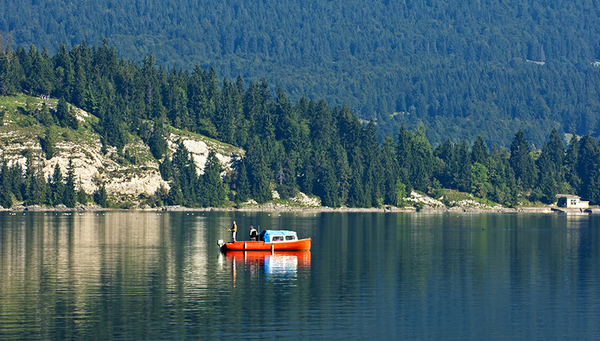News Detail
Traces of history in the sediments of Lake Joux
January 28, 2016 |
The Joux Valley in the Jura Mountains of Canton Vaud is mainly known as a traditional watchmaking centre. There is also some agriculture and, in the winter, the region attracts cross‑country skiing enthusiasts. The landscape is dominated by a lake with an area of around nine square kilometres – Lake Joux. The Joux Valley is now largely forested: Grand Risoux, for example, is Switzerland’s largest contiguous wooded area (Fig. 1). But in the past, it looked quite different. From the 14th century onwards, this remote high-lying valley was settled by farmers, who – to make the land more suitable for cattle breeding – drained wetlands and cleared large areas of forest.
However, the Joux Valley was not an ideal region for farming. Around the middle of the 15th century, the Little Ice Age brought increasingly cold and wet weather, leading to repeated crop failures and food shortages. The inhabitants, forced to diversify, began to exploit the remaining forests. The wood industry rapidly became an important source of income, and sawmills and charcoal burning flourished. Charcoal soon also fuelled the emerging metal industry. Along with iron mining, metalworking forges were established. In the 17th century, glassmakers and lapidaries also plied their trades. Finally, the late 18th century saw the introduction of watchmaking, which developed into the region’s most important sector in the 19th century. As a result of industrialization, agriculture declined, and cultivated fields were gradually replaced by pastureland or fallows.
Sediment archive dating back 1200 years
The history of human settlement in the Joux Valley is well documented in historical sources. But it is also recorded in the sediments of Lake Joux, as Nathalie Dubois – head of the Sedimentology group in Eawag’s Surface Waters department – explains: “Lake sediments are precious natural archives. Depending on the prevailing local conditions and influences, different substances are deposited on the lake bottom over time.” Scientists like Dubois who can interpret the various layers of sediments can thus gain valuable insights into a region’s history. Together with Marlène Lavrieux (a postdoc) and other co-workers, she investigated how the settlement and economic development of the Joux Valley is reflected in the sediments of Lake Joux.
For the study, sediment cores almost a metre long were extracted, using plastic tubes driven into the lake bottom (Fig. 2). Two cores were bisected, and samples were examined in detail in the laboratory: magnetic susceptibility and X-ray fluorescence scanning, density measurements and geochemical analyses were performed, as well as radiocarbon, lead-210 and caesium-137 dating. The sediment composition was also assessed visually with the aid of high-resolution photographs. “The cores date back around 1200 years,” says Dubois.
Erosion due to forest clearance
The sediment cores reveal the varied history of the Joux Valley (Fig. 3). Explaining the findings, Dubois notes: “Until the 13th century, environmental influences predominate, with the earliest settlers leaving no traces in the sediments.” Alternating layers of dark brown mud (known as gyttja) and lighter carbonate deposits indicate climatic fluctuations. The effects of human activities are first discernible in the overlying layers. Here, the plant constituents show a different pattern of long-chain hydrocarbons than in earlier layers. According to the researchers, this is due to a marked increase in inputs of organic matter to the lake, occurring between 1300 and 1450. During this period, numerous settlers arrived in the valley and began to clear the forests. Large amounts of organic matter from the bare soil were thus washed into Lake Joux. The increasingly wet climate – heralding the Little Ice Age – also contributed to soil erosion.
These inputs peaked around 1500. Nutrients entering the lake with the soil promoted algal growth, as indicated by algal debris in the sediments. As economic development progressed and farmland was abandoned, erosion started to decline from around 1600. The composition of the sediment changed. Iron mining, which flourished at this time, left few traces. However, the bursting of a dike shortly after its construction in 1777 did have a visible impact: large quantities of sediments were disturbed or swept away. In addition, there was a drop in the lake water level. This, combined with growing evaporation due to warmer climatic conditions, led in the 19th century to increased precipitation of calcium carbonate. “So the sediments from this period are marked by lighter carbonate layers,” says Dubois.
Heavy metals from the watchmaking industry?
In 1942, as part of a hydropower scheme, a more robust dam was built between Lakes Joux and Brenet. The silty deposits observed in the sediment cores suggest that, at this time, construction wastes were discharged into the lake. The dam also altered the dynamics of Lake Joux, with flows being restricted in certain areas. Together with increased inputs of phosphorus from detergents, this promoted eutrophication of the lake. The carbon isotope composition of the sediment layers from this period indicates increased growth of aquatic plants and rising nutrient concentrations.
Around 1950, lead, zinc, iron and copper suddenly appear in the sediment layers. “According to our analyses,” says Dubois, “the heavy metals are of anthropogenic origin.” One possible source is the local watchmaking industry. The lead may also derive from the metalworking sector or from leaded petrol (atmospheric inputs).
Dubois concludes that examination of the sedimentary archive is a promising approach for tracing the impacts of human activity on a region: “It can also indicate how the environment or climate are affected by current activities, or the resilience of ecosystems to human-induced disturbances.” As the next step, the sedimentologist plans to collaborate with ecologists in studying the traces left by history in the aquatic organisms of Lake Joux.



